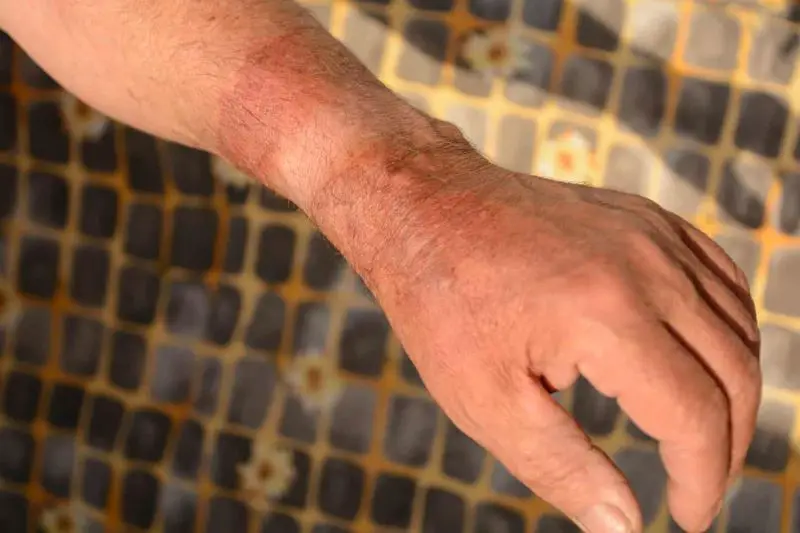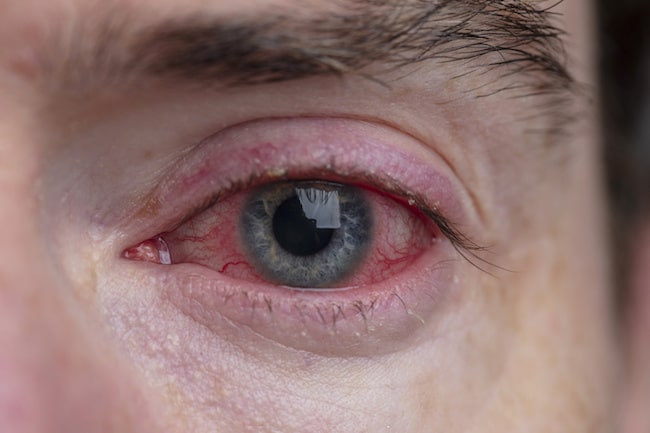Welding releases UV rays and intense flashes that can burn your exposed skin in minutes and cause substantial discomfort and damage to your eyes, not to mention the sparks that can cause long-term harm.
Metal is heated to high temperatures during preheating and welding, and the welding arc generates very concentrated rays that can cause sunburns very rapidly.
Welding sunburn can be painful and can have long term effects on your health. And constant exposure to harmful UV rays and heat from welding can result in fatal consequences. Welding generates ultraviolet and infrared radiation, both of which are known to cause skin cancer.
Apart from your skin, even your eyes can be injured as a result of being exposed to bright UV light and sparks. Burns in your eyes are known as flash burns or welder’s flash. Both skin and eyes are sensitive areas that need maximum protection from welding dangers.
How can welding cause sunburn?
There are various reasons why you might get sunburn while welding-
1.) Welding creates a very powerful light. This laser is liquifying metal at extraordinarily high temperatures ranging from 10,000 to 15,000 degrees. That is, believe it or not, hotter than the surface of the sun.
2.) Along with this strong light, welding emits ultraviolet and infrared light, both of which are invisible to the naked eye. Ultraviolet light is generated by extremely hot things, such as the sun or a welder.
3.) Then there’s infrared light, which is created by the heat emitted by a weld. You won’t be able to see it, but you will most likely feel it.
In most circumstances, your welding gear will block UV and IR, but if you have exposed skin on your neck or arms, it will burn if it receives too much.
Symptoms of welding sunburn
Skin
-
-
- Inflamed skin that appears pink or red.
- Skin feels warm or heated when touched.
- Itching, pain, and tenderness
- Swelling.
- Small, fluid-filled blisters that may rupture and cause more pain.
- If the sunburn is severe, it might cause headaches, fever, nausea, and exhaustion.
-
Eyes
Among the symptoms are:
-
-
- Pain ranging from a moderate sensation of pressure in the eyes to excruciating pain in extreme cases.
- Tearing and reddening of the eye and its membranes.
- “Sand in the eye” feeling, which causes great discomfort.
- Abnormal sensitivity to light
- Difficulty to stare at light sources, also known as photophobia.
-
The time necessary to generate these effects is determined by various factors, including the strength of the radiation, the distance from the welding arc, the angle at which the radiation comes in contact with the skin or enters the eye, and the type of protection worn by the welder.
However, even a few seconds of severe UV light exposure might produce an arc eye and may cause your skin to burn. These effects may not manifest themselves for some hours after exposure.
See also: Is Welding Flash Burn as Dangerous as Sunburn?
What are permanent effects of welding sunburn?
Welding generates ultraviolet and infrared radiation, both of which are known to cause skin cancer. Excessive exposure to these dangerous lights might increase your risks.
Arms, chest, neck, and face should all be protected. Finally, inspect your skin for any irregularities and notify your doctor.
As for the eyes, if your flash eye is severe and goes untreated, it may cause permanent blindness as too much UV exposure damages the cornea.
That is why you need to be careful, ensure that you have your full PPE on while welding and even though you have sunburn, take proper care of it.
Prevention of welding sunburn
When it comes to welding sunburn, prevention is crucial. When it is possible to get sunburned while welding, it is also simple to avoid.
By following a safe method and wearing protective gear, one may simply limit the danger by taking the appropriate steps.
To avoid welding sunburns, use adequate protective clothing. You must wear it no matter how hot it is. Nothing is more important than your safety.
UV protection apparel should comprise the following items:
-
-
- Helmet for welding.
- Gloves for welding.
- Jacket made of leather.
- Pants made of leather.
-
1. Helmet
Choosing the correct helmet for you is critical and is linked to your welding process. Because different welding techniques generate varying levels of UV intensity, you’ll need your helmet to protect you adequately.
You may even think about purchasing goggles instead of a helmet. These, however, simply conceal your eyes. Getting a helmet is therefore more effective because it protects the entire face rather than just the eyes.
2. Gloves
Gloves protect your hands from splatter, sparks, and heat. There are specialized gloves available for this purpose. The thickness and kind of leather used in welding gloves vary based on the model.
The finest welding gloves will shield your hands from the heat, splatter, and sparks produced during the welding process.
Some welders apply additional flame-resistant material to the areas of their hands closest to the welding arc.
3. Jacket
Investing in a work jacket is vital. There are hefty coats that will shield you from both the welder’s UV rays and the cold weather if you operate in a chilly environment or outside.
If you’re welding in a warmer area or workshop, you may also wear an apron to protect yourself with something lighter in weight.
4. Pants
Pants are an important part of your welding PPE as it helps to safeguard your thighs and legs from burns. Get yourself a strong, FR pant that will not let heat, spark or any UV rays penetrate through them and harm your skin.
Treatment of welding sunburn
Now that you know how can you prevent getting welding sunburn, here are a few first aid tips you can do immediately-
For skin-
1. Clean the burn area well
The first thing you should do is clear up the charred area. You’ll want to do this since a welding shop isn’t the cleanest location.
Begin by cleaning the area with a clean, cold, soapy towel. However, avoid the towel if it feels harsh. You may use a soft cotton handkerchief.
2. Use a cooling ointment.
You may use aloe ice to help hydrate the burned skin. It has the added benefit of providing a cooling sensation after application. In most situations, repeating this a few times over the following several days will resolve the problem.
However, if you’ve been severely burned, you should use burn cream.
If you’ve been severely burned, you should apply burn cream. Burn cream is an over-the-counter solution that you may use to the burn area to provide relief from the burn.
3. Dressings and bandages
If things aren’t improving, consider utilizing burn relief dressing, which allows you to wrap and cover the burn.
If you’re in this circumstance, this will allow you to wrap it and keep it out of any damaging light without making the condition worse.
4. Seek medical assistance
Finally, if the burn is not improving or worsening, it is necessary to seek medical assistance. A brief trip to your family doctor can often allow you to obtain a prescription medicine to utilize.
If the situation is critical, get medical care right once. If you are feeling severe burn pain on your skin and eyes, you should get medical attention right away.
For eyes
The creation of welding arcs is a fundamental aspect of welding. As the arc and flash get closer to the eyes, more UV radiation is absorbed.
It is sad that welders continue to operate without protective helmets and gaze directly into the eyes. You may take steps to avoid welding arc eyes.
Wear goggles to protect your eyes- Use welder-specific goggles that are thoroughly covered with a UV light protection system.
If you’re welding all day, the sunglasses provide Ultraviolet A and Ultraviolet B protection on the inside. These glasses can protect your eyes and cornea from these two UV rays.
- Mask- Wear a welder’s mask with a filter that has been approved by government safety and protection regulations.
- PPE kits- Personal protection equipment (PPE) is required for welding operations, as well as correct working gear, especially for the eyes to safeguard it from heat and UV light.
Conclusion
Sunburn and flash burns are injuries that can be easily avoided by just taking a few measures to ensure your safety. Welding can be harmful, but so can a variety of other activities.
All you have to do is be vigilant, wear your protective clothing, and even though you get sunburn after protection, this article has got you covered.









